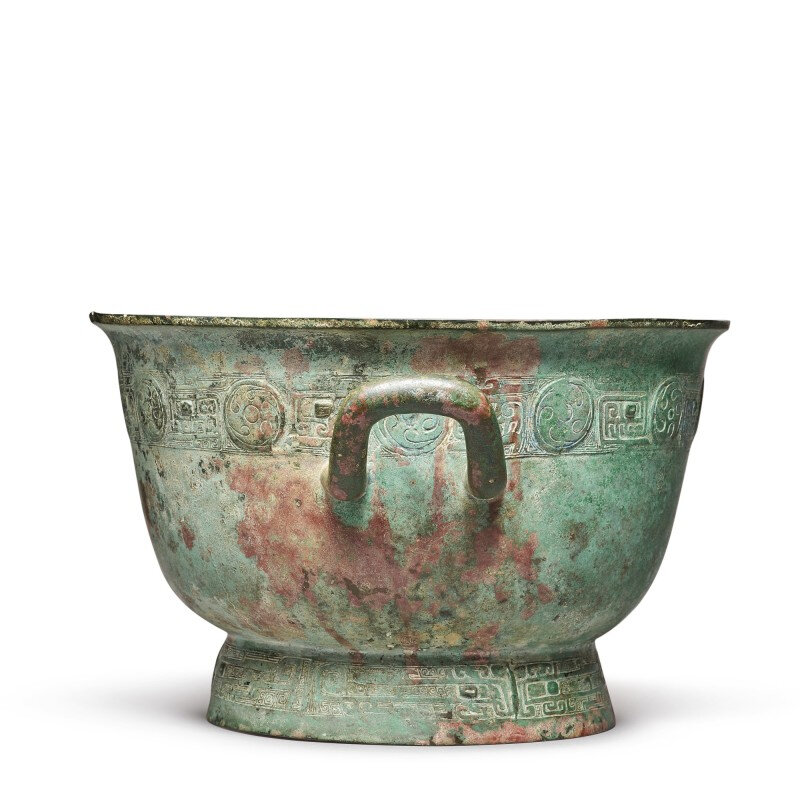A rare archaic bronze ritual food vessel (Gui), Late Shang dynasty
Lot 192. A rare archaic bronze ritual food vessel (Gui), Late Shang dynasty. Width 14 ¾ in., 37.5 cm. Estimate: 200,000 - 300,000 USD. Lot sold: 504,000 USD. Courtesy Sotheby's.
well cast with the deep rounded sides rising from a splayed foot to a flared rim, flanked by a pair of upturned U-shaped handles, the exterior finely decorated under the rim with a band of formalized kuilong alternating with whorled medallions, the foot further encircled by a band of three taotie masks reserved on a leiwen ground, the interior cast with a single-character inscription reading ge, the surface with malachite encrustation.
Exhibited: Fitchburg Art Museum, Massachusetts, 2005-2015 (on loan).
Note: The present bronze vessel is cast with the deep U-shaped bowl supported on a tall foot and flanked by a pair of upturned loop handles. This particular form has been identified by archaic bronze inscriptions as gui or yu. See, for example, a vessel of this type, cast to the interior with Zhong zuo bao gui (precious gui made by Zhong), published in Wu Zhenfeng, Shangzhou qingtongqi mingwen ji tuxiang jicheng [Compendium of inscriptions and images of bronzes from the Shang and Zhou dynasties], vol. 8, Shanghai, 2012, no. 04127; and one from the Qing Court Collection, now in the Palace Museum, Beijing, inscribed with a fifteen-character inscription identifying it as a yu made by Bo, published in The Complete Collection of Treasures of the Palace Museum. Bronze Ritual Vessels and Musical Instruments, Hong Kong, 2006, pl. 47.
The differentiation between gui and yu of this type can sometimes be challenging. A widely established method of classification, which has been accepted by multiple contemporary scholars, appears to be based on the size of the vessels. Ma Chengyuan suggested in his book that small vessels of this form are gui, and medium or large vessels are yu (see Zhongguo qingtongqi/The Chinese Bronzes, Shanghai, 2010, p. 151). Zhu Fenghan further noted in his book that bronze yu are usually large in size, averaging over 40 cm in height and 55 cm in diameter (see Zhongguo qingtongqi zonglun/A Comprehensive Survey of Chinese Bronzes, vol. 1, Shanghai, 2009, p. 307).
Although bronze gui of this type are known from the late Shang to Western Zhou dynasty, the overall form of the present bronze indicates a late Shang dynasty attribution. Compare a smaller vessel of a very similar form, but with an unidentified fitting to the interior, attributed to the first half of the Yinxu period, excavated at Xibeigang in Anyang, Henan province, included in the exhibition King Wu Ding and Lady Hao. Art and Culture of the Late Shang Dynasty, National Palace Museum, Taipei, 2012, cat. no. III-4. Related Western Zhou dynasty examples are usually modeled with a more compressed body and a spreading foot, such as one from the Qing Court Collection, now in the Palace Museum, Beijing, illustrated in the Palace Museum, ed., Gugong qingtongqi/ Bronzes in the Palace Museum, Beijing, 1999, no. 116; and another published in Zhang Shengfu and Zhang Tunsheng, Shaanxi chutu shangzhou qingtongqi [Bronzes of Shang and Zhou dynasties unearthed in Shaanxi Province], vol. 2, Beijing, 1980, pl. 103.
The present gui is cast to the interior with a single character ge (dagger-axe), which is the name of an ancient clan mostly active in the Shaanxi and Henan areas during the Shang to early Western Zhou period. Apart from appearing in bronze inscriptions, the ge name also occurs in oracle bone inscriptions, which indicates the prominent social status of this clan during the Shang dynasty. Jessica Rawson also noted the importance of this pictogram in her book Western Zhou Ritual Bronzes from the Arthur M. Sackler Collections, vol. IIB, Washington, D.C., 1990, p. 455. See several other late Shang dynasty bronze gui with the ge pictogram, some of which are now preserved in major museums, published in Wu Zhenfeng, op. cit., vol. 7, nos 03515-03521.
Sotheby's. Important Chinese Art, New York, 17 march 2021

/https%3A%2F%2Fprofilepics.canalblog.com%2Fprofilepics%2F1%2F0%2F100183.jpg)
/https%3A%2F%2Fstorage.canalblog.com%2F03%2F02%2F119589%2F96711876_o.jpg)
/https%3A%2F%2Fstorage.canalblog.com%2F11%2F31%2F119589%2F94773502_o.jpg)
/https%3A%2F%2Fstorage.canalblog.com%2F20%2F83%2F119589%2F94772815_o.jpg)
/https%3A%2F%2Fstorage.canalblog.com%2F26%2F72%2F119589%2F75604929_o.jpg)
/https%3A%2F%2Fstorage.canalblog.com%2F59%2F60%2F119589%2F26458628_o.jpg)










/image%2F1371349%2F20240310%2Fob_c0e13b_431753965-1629270041176342-17091014609.jpg)
/http%3A%2F%2Fstorage.canalblog.com%2F09%2F18%2F119589%2F129831747_o.jpg)
/http%3A%2F%2Fstorage.canalblog.com%2F61%2F12%2F119589%2F129820770_o.jpg)
/http%3A%2F%2Fstorage.canalblog.com%2F45%2F15%2F119589%2F129820620_o.jpg)